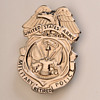Posted 9 years ago
 Chrisnp
Chrisnp
(310 items)
Before moving on from my German sword posts, I’m sharing a partially identified sword from my collection since at least I am certain of its German manufacture.
The sword bears the knight’s head logo of the Kirschbaum family of sword makers in Solingen in Westphalia/Prussia/Germany (depending on the era in question). The Kirschbaums were making things for people to stab each other with since the 1400s. The knight’s head logo goes back at least to 1814 when Carl Kirschbaum used it on his swords. He passed the logo on to his son Wilhelm, who continued to use it till 1883, when he merged with another sword making family, the Weyersburgs.
Unfortunately, German manufacture does not mean German use. The Kirschbaums happily sold swords to practically anyone who wanted to take a poke at someone else. For example, in 1858 they made sword bayonets for England, and sold cavalry swords to the U.S. during the Civil War.
This sword was clearly made to be used in battle, not ceremony. The blade is fairly massive, making the hilt look almost disproportionately small. Yet, the sword is surprisingly light. My opinion is that it was made in the first part of the 19th century. The etching (which is barely visible) is much more similar to the early part of that century than the latter part. Unfortunately the etching gives no clue to the intended user.
The blade is similar to the British 1796 light cavalry saber or 1811 Prussian “Blucher” type sword in that the width of the fuller almost takes over the whole side of the blade, and the tip of the sword tapers up instead of coming to a spear point – although it’s not as curved as those swords. Also, the taper at the back of the grip is similar to those swords, but more pronounced here. The three branch brass hilt is similar to several German, British and American patterns, but none exactly.
So, ideas anyone?




















Still yet another fine sword with an excellent description. I wish I had something intelligent to add. Looks to be a functional sword.
Thanks for the comment fortapache, and thanks for the love paulmartin, Manikin, blunder, racer4four, fortapache and aghcollect